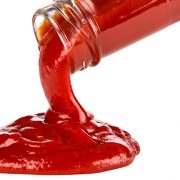Gummy candy production line
Gummy candy is a unique candy made of gelatin, sweeteners flavors and colors. Due to its nature, it can be molded into a huge variety shapes, making it one of the most versatile confection products ever.
Originally developed in Germany in the early 1900s, it gained popularity in the United States during the 1980s. Today, it has gained popularity around the world.
Basic materials used in gummy candy
Gummy candy recipes are typically developed by experienced food technologists and chemists. By blending together different ingredients, they can control the various characteristics of gummy candy, such as texture, taste, and appearance. The main ingredients are water, gelatin, sweetener, flavor and color.
The main ingredient responsible for the candy’s unique, gummy characteristics is gelatin. This is a protein derived from animal tissue that forms thick solutions or gels when placed in water. When used at an appropriate concentration, the gels take on the texture of the chewy, gummy candy. However, since these gels get thinner as they are heated, gummy candies have a “melt in the mouth” characteristic. Both the texture and the amount of time it takes the candy to dissolve in the mouth can be controlled by the amount of gelatin used in a recipe.
Since gelatin is a tasteless and odorless compound that contains no fat, sweeteners and flavorings are added to give gummy candy its taste.
Various sugars used as sweeteners
- Sucrose: This kind of sweetener derived from beets or sugar cane, provides a high degree of sweetness to the gummy candy.
- Fructose: This kind is significantly sweeter than common sucrose, is another sugar that is often used.
- Corn syrup; Corn syrup is also used because it helps prevent the other sugars from crystallizing and ruining the gummy texture. Also, corn syrup helps add body to the candy, maintain moisture, and keep costs lower.
- Sorbitol: Sorbitol has the added benefit of helping the candy maintain its moisture content.
In addition to flavor, some of these sweeteners have the added benefit of preserving the gummy candy from microbial growth.
The sweetness of gummy candy is only one of its characteristics. Artificial and natural flavors are also used to create a unique taste.
The Manufacturing Process of gummy candy
At first the candy is made, then it is filled into starched lined trays. The filled trays are then cooled down and the resulting formed candy is emptied from the trays. In the mass production of gummy candy, significant improvements have been made to increase the speed and efficiency of this process.
Step1) Compounding
The manufacture of gummy candy begins with compounding. Factory workers, known as compounders, follow instructions outlined in the recipes and physically pour the appropriate amount of gummy raw materials into the main mixing tanks. These tanks, which are equipped with mixing, heating, and cooling capabilities, are quite large. Depending on the size of the batch, gummy candy compounding can take from one to three hours.
Step2) Quality control
When the batch is complete, it is sent to the Quality Control (QC) laboratory to make sure that it meets the required specifications.
Step3) Forming candy
After the gummy candy is compounded and passes QC testing, it is either pumped or transferred to a starch molding machine known as a Mogul. This machine can automatically perform the multiple tasks involved in making gummy candy. It is called a starch molding machine because starch is a main component. In this machine, starch has three primary purposes:
-First, it prevents the candy from sticking to the candy molds, which allows for easy removal and handling.
-Second, it holds the gummy candy in place during the drying, cooling, and setting processes.
-Third, it absorbs moisture from the candies, giving them the proper texture.
Step4) Conveyer belt
Making gummy candy in a Mogul is a continuous process. At the start of the machine, trays that contain previously filled, cooled, and formed gummy candy are stacked. The trays are then removed from the stack one-by-one and wove along a conveyor belt into the next section of the machine, known as the starch buck.
Step5) Separation
As they enter the starch buck, the trays are inverted and the gummy candy falls out into a vibrating metal screen known as a sieve. The vibrating action of the sieve, in concert with oscillating brushes, removes all of the excess starch that adheres to the gummy candy.
Step6) Starch cleaning
The extra starch removed from the sure face of gummy candies, is reused in a process, but first it must be clean, dry, or otherwise reconditioned.
Step7) Packaging
Then the prepared pieces of gummy candies are sent to the packaging stage by the conveyor.
Consultation on Launching the gummy candy Production Line
If you are interested in installing and equipping a gummy candy production line, you can easily contact our colleagues in the Shabchare food industry.






Leave a Reply